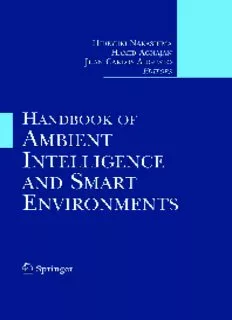Table Of ContentHandbook of Ambient Intelligence and Smart
Environments
· ·
Hideyuki Nakashima Hamid Aghajan
Juan Carlos Augusto
Editors
Handbook of Ambient
Intelligence and Smart
Environments
123
Editors
HideyukiNakashima HamidAghajan
FutureUniversityHakodate DepartmentofElectricalEngineering
Kameda-Nakano116-2 StanfordUniversity
Hakodate,Hokkaido 350SerraMall
041-8655Japan Stanford,CA94305-9515
h.nakashima@fun.ac.jp USA
aghajan@stanford.edu
JuanCarlosAugusto
SchoolofComputing&Mathematics
UniversityofUlsteratJordanstown
ShoreRoad,Newtownabbey,Co.Antrim
UKBT370QB
jc.augusto@ulster.ac.uk
ISBN978-0-387-93807-3 e-ISBN978-0-387-93808-0
DOI10.1007/978-0-387-93808-0
SpringerNewYorkDordrechtHeidelbergLondon
LibraryofCongressControlNumber:2009935679
(cid:2)c SpringerScience+BusinessMedia,LLC2010
Chapter11(cid:2)c2009FrankStajano.Usedwithpermission
Allrightsreserved.Thisworkmaynotbetranslatedorcopiedinwholeorinpartwithoutthewritten
permission of the publisher (Springer Science+Business Media, LLC, 233 Spring Street, New York,
NY 10013, USA),except for brief excerpts in connection with reviews orscholarly analysis. Usein
connection with any form of information storage and retrieval, electronic adaptation, computer
software,orbysimilarordissimilarmethodologynowknownorhereafterdevelopedisforbidden.
The use in this publication of trade names, trademarks, service marks, and similar terms, even if
they are not identified as such, is not to be taken as an expression of opinion as to whether or not
theyaresubjecttoproprietaryrights.
Printedonacid-freepaper
SpringerispartofSpringerScience+BusinessMedia(www.springer.com)
Contents
PartI Introduction
AmbientIntelligenceandSmartEnvironments:AStateoftheArt ..... 3
JuanCarlosAugusto,HideyukiNakashima,HamidAghajan
1 Introduction............................................. 3
2 Sensors,Vision,andNetworks ............................. 7
3 MobileandPervasiveComputing........................... 10
4 Human-centeredInterfaces ................................ 14
5 ArtificialIntelligenceandRobotics ......................... 17
6 Multi-Agents............................................ 20
7 Applications ............................................ 22
8 SocietalImplicationsandImpact ........................... 24
9 SelectedResearchProjects ................................ 26
10 PerspectivesoftheArea................................... 29
11 Conclusions............................................. 30
References.................................................... 31
PartII Sensor,VisionandNetworks
ASurveyofDistributedComputerVisionAlgorithms................ 35
RichardJ.Radke
1 Introduction............................................. 35
2 DistributedAlgorithms.................................... 37
3 TopologyEstimation ..................................... 38
3.1 Non-overlappingTopologyEstimation............... 40
3.2 OverlappingTopologyEstimation................... 41
4 CameraNetworkCalibration............................... 42
4.1 Non-overlappingCameraCalibration................ 43
v
vi Contents
4.2 OverlappingCameraCalibration.................... 44
4.3 ImprovingCalibrationConsistency.................. 45
5 TrackingandClassification ................................ 47
6 Conclusions............................................. 49
References.................................................... 50
Video-BasedPeopleTracking .................................... 57
MarcusA.Brubaker,LeonidSigalandDavidJ.Fleet
1 Introduction............................................. 57
1.1 TrackingasInference ............................. 58
2 GenerativeModelforHumanPose.......................... 60
2.1 KinematicParameterization........................ 60
2.2 BodyGeometry.................................. 61
2.3 ImageFormation................................. 62
3 ImageMeasurements ..................................... 62
3.1 2DPoints ....................................... 63
3.2 BackgroundSubtraction........................... 64
3.3 AppearanceModels............................... 65
3.4 EdgesandGradientBasedFeatures ................. 66
3.5 Discussion ...................................... 68
4 MotionModels .......................................... 68
4.1 JointLimits ..................................... 69
4.2 SmoothnessandLinearDynamicalModels........... 69
4.3 ActivitySpecificModels .......................... 70
4.4 Physics-basedMotionModels...................... 72
5 Inference ............................................... 73
5.1 ParticleFilter .................................... 74
5.2 AnnealedParticleFilter ........................... 75
5.3 MarkovChainMonteCarloFiltering ................ 78
6 InitializationandFailureRecovery.......................... 79
6.1 Introductionto DiscriminativeMethodsfor Pose
Estimation ...................................... 80
6.2 DiscriminativeMethodsasProposalsforInference .... 82
7 Conclusions............................................. 82
References.................................................... 83
LocomotionActivitiesinSmartEnvironments ...................... 89
BjörnGottfried
1 Introduction............................................. 89
1.1 WhyLocomotionMatters.......................... 89
1.2 Overview ....................................... 90
2 RelatedWorkonMotionAnalysisandSmartEnvironments..... 90
2.1 MotionParameters ............................... 91
2.2 Precision........................................ 91
2.3 Viewpoint....................................... 92
2.4 Wayfinding...................................... 92
Contents vii
2.5 Modelling....................................... 93
2.6 Summary ....................................... 94
3 LocomotionActivitiesinSmartEnvironments ................ 94
3.1 SmartHospitals.................................. 94
3.2 ScenariosinaSmartHospital ...................... 96
3.3 CharacterisingLocomotionActivities................ 98
4 TheRepresentationofLocomotionActivities................. 101
4.1 SpatiotemporalInformation........................ 101
4.2 FunctionalSpecification........................... 102
4.3 AllocentricView ................................. 104
5 LocomotionBasedAlgorithms ............................. 104
5.1 PlanningScenario ................................ 105
5.2 WayfindingScenario.............................. 106
5.3 SearchingScenario ............................... 106
5.4 MonitoringScenario.............................. 108
6 Discussion .............................................. 109
7 Outlook ................................................ 110
8 Summary ............................................... 111
References.................................................... 112
TrackinginUrbanEnvironmentsUsing SensorNetworksBasedon
Audio-VideoFusion ............................................ 117
ManishKushwaha,SonghwaiOh,IsaacAmundson,XenofonKoutsoukos,
AkosLedeczi
1 Introduction............................................. 117
2 ChallengesandRelatedWork .............................. 119
3 Architecture............................................. 121
4 AudioBeamforming...................................... 123
5 VideoTracking .......................................... 125
6 TimeSynchronization .................................... 128
6.1 SynchronizationMethodology...................... 128
6.2 EvaluationofHSNTimeSynchronization ............ 129
6.3 SynchronizationService........................... 130
7 MultimodalTargetTracking ............................... 131
7.1 SequentialBayesianEstimation..................... 132
7.2 SensorModels................................... 134
7.3 Multiple-TargetTracking .......................... 136
8 Evaluation .............................................. 137
8.1 SequentialBayesianEstimation..................... 137
8.2 MCMCDA ...................................... 141
9 Conclusions............................................. 144
References.................................................... 145
viii Contents
Multi-CameraVisionforSurveillance ............................. 149
NorikoTakemuraandHiroshiIshiguro
1 Introduction............................................. 149
2 CameraSystems ......................................... 150
2.1 FixedCamera.................................... 150
2.2 ActiveCamera................................... 152
2.3 MixedSystem ................................... 152
2.4 Multi-modalSystem .............................. 154
2.5 SurveillanceIssues ............................... 154
2.6 LocationandSubjects............................. 156
2.7 Occlusion....................................... 156
3 CaseStudies ............................................ 157
3.1 Real-timecooperativemulti-targettrackingbydense
communicationamongActiveVisionAgents ......... 157
3.2 TrackingMultipleOccludingPeoplebyLocalizingon
MultipleScenePlanes............................. 158
3.3 ApplyingaFormofMemory-basedAttentionControl
toActivityRecognitionataSubwayStation .......... 160
3.4 DMCtrac:DistributedMultiCameraTracking........ 161
3.5 Abnormal behavior-detection using sequential
syntacticalclassification in a networkofclustered
cameras......................................... 163
4 IndustrySystems......................................... 163
5 Conclusion.............................................. 164
6 FurtherReading ......................................... 165
References.................................................... 165
PartIII MobileandPervasiveComputing
CollaborationSupportforMobileUsersinUbiquitousEnvironments... 173
BabakA.FarshchianandMonicaDivitini
1 Introduction............................................. 173
2 CharacteristicsofCollaboration ............................ 174
2.1 CollaborationandSharedContext................... 174
2.2 EmbodiedInteractionsandArtifactsasResources ..... 177
2.3 MobilityofPeopleandResources................... 178
2.4 PhysicalDistributionofPeople ..................... 178
2.5 FlexibilityandtheNeedforTailoring................ 179
3 ExistingTechnologyinSupportofUbiquitousCollaboration.... 180
4 HumanGridasaUnifyingConceptforAmIandCSCW........ 181
4.1 TheExampleofUbiBuddy......................... 183
4.2 SharedContextinHumanGrid ..................... 186
4.3 EmbodimentinHumanGrid ....................... 186
4.4 MobilityinHumanGrid........................... 187
4.5 SupportforPhysicalDistributioninHumanGrid ...... 187
Contents ix
4.6 FlexibilityandTailoringinaHumanGrid ............ 187
5 ImplementationofHumanGrid:TheUbiCollabPlatform....... 188
5.1 UbiNodeOverallArchitecture...................... 189
5.2 CollaborationInstanceManager .................... 190
5.3 SessionManager ................................. 192
5.4 CollaborationSpaceManager ...................... 192
5.5 ServiceDomainManager.......................... 193
5.6 ResourceDiscoveryManager ...................... 193
5.7 IdentityManager................................. 194
6 Conclusions............................................. 195
7 Acknowledgements ...................................... 196
References.................................................... 196
PervasiveComputingMiddleware ................................ 201
GregorSchiele,MarcusHandteandChristianBecker
1 Introduction............................................. 201
2 DesignConsiderations .................................... 202
2.1 OrganizationalModel............................. 202
2.2 ProvidedLevelofAbstraction...................... 204
2.3 SupportedTasks ................................. 205
3 SpontaneousInteraction................................... 206
3.1 UbiquitousCommunicationandInteraction........... 207
3.2 IntegrationofHeterogeneousDevices ............... 210
3.3 DynamicMediation............................... 211
4 ContextManagement..................................... 214
4.1 AcquisitionandFusion............................ 216
4.2 ModelingandDistribution ......................... 217
4.3 ProvisioningandAccess........................... 218
5 ApplicationAdaptation ................................... 218
5.1 Inter-ApplicationAdaptation....................... 219
5.2 Intra-ApplicationAdaptation....................... 222
6 Conclusion.............................................. 224
References.................................................... 225
CaseStudy ofMiddleware InfrastructureforAmbient Intelligence
Environments ................................................. 229
TatsuoNakajima
1 Introduction............................................. 229
2 HighLevelAbstraction ................................... 232
3 CaseStudies ............................................ 233
3.1 MiddlewareInfrastructureforDistributedAudioand
VideoAppliances ................................ 233
3.2 MiddlewareInfrastructuretoHideComplexDetailsin
UnderlyingInfrastructures......................... 237
3.3 MiddlewareInfrastructuretoSupportSpontaneous
SmartObjectIntegration .......................... 241
x Contents
3.4 MiddlewareInfrastructureforContextAnalysis ....... 245
4 MiddlewareDesignIssuesforAmbientIntelligence ........... 249
4.1 HighLevelAbstractionandMiddlewareDesign....... 249
4.2 Interfacev.s.Protocol............................. 249
4.3 NonFunctionalProperties ......................... 250
4.4 Portability....................................... 251
4.5 HumanFactors................................... 251
5 FutureDirections ........................................ 253
References.................................................... 253
CollaborativeContextRecognitionforMobileDevices ............... 257
PerttiHuuskonen,JaniMäntyjärviandVilleKönönen
1 Introduction............................................. 257
1.1 Humans:Context-awareAnimals ................... 258
2 ContextFromCollaboration ............................... 259
3 MobileContextAwareness ................................ 260
3.1 ContextSources.................................. 260
3.2 ApplicationAreas ................................ 262
3.3 ContextRecognition.............................. 263
3.4 DistributedContextAwareness ..................... 264
4 MakingRationalDecisions ................................ 264
4.1 DistributedDecisionMaking....................... 265
4.2 Voting Protocolsas Distributed Decision Making
Strategies ....................................... 265
4.3 VotingasCCRMethod............................ 266
5 CaseStudy:PhysicalActivityRecognition ................... 270
5.1 DataSetandTestSettings ......................... 270
5.2 EmpiricalResults ................................ 272
6 ContextRecognitionPlatform.............................. 273
7 TheWayForward........................................ 274
7.1 EnergySavings .................................. 274
7.2 Risks........................................... 275
7.3 Knowledge-basedCCR?........................... 276
References.................................................... 277
SecurityIssuesinUbiquitousComputing .......................... 281
FrankStajano
1 FundamentalConcepts.................................... 281
1.1 Ubiquitous(Pervasive,Sentient,Ambient...)Computing 282
1.2 Security ........................................ 284
1.3 SecurityIssuesinUbiquitousComputing............. 286
2 ApplicationScenariosandTechnicalSecurityContributions .... 287
2.1 WearableComputing ............................. 288
2.2 LocationPrivacy ................................. 289
2.3 RFID........................................... 292
2.4 AuthenticationandDevicePairing .................. 298
Description:Ambient Intelligence (AmI) has recently been adopted as a term referring to a multidisciplinary subject which embraces a variety of pre-existing fields of computer science and engineering. Given the diversity of potential applications this relationship naturally extends to other areas of science, su

